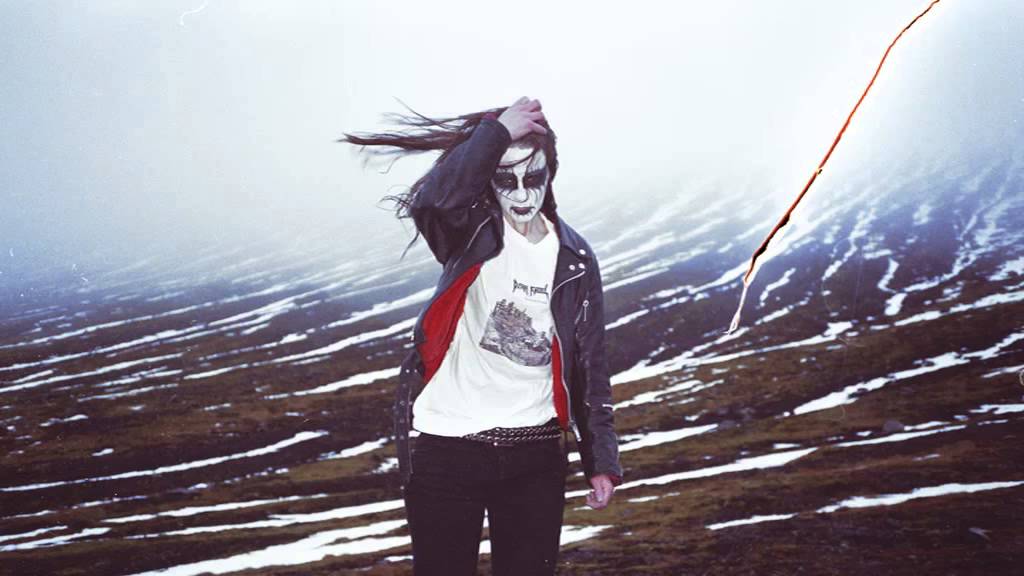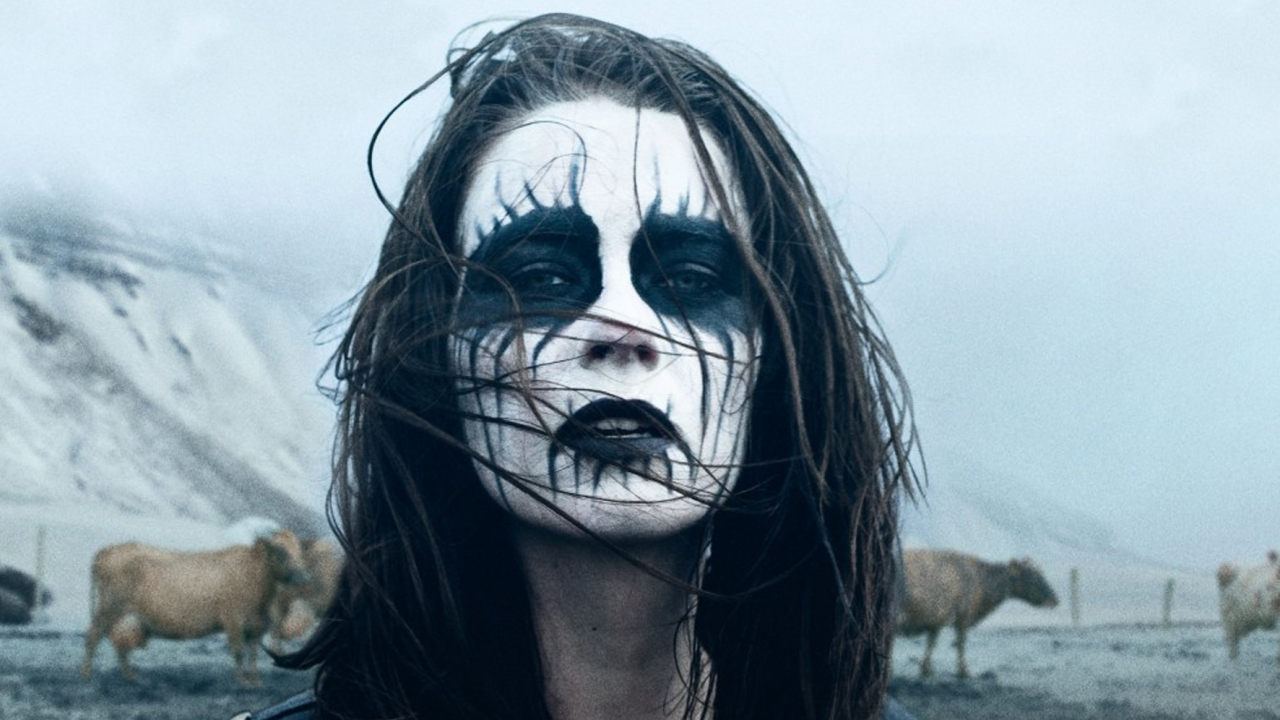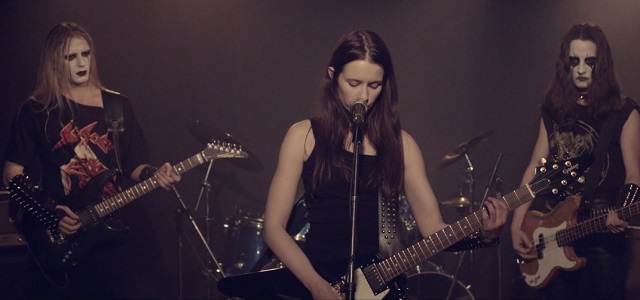Metalhead (Málmhaus) is an Icelandic film from 2013 that played in Seattle as part of the 2015 Nordic Lights Film Festival. Directed by Ragnar Bragason, Metalhead was very successful in the Icelandic 2014 Edda Awards, winning for Best Actress, Best Supporting Actress, Best Supporting Actor, Best Editing, Best Costume Design, Best Sound, Best Original Score and Best Make-up.
Plot of Metalhead
Metalhead tells the story of 12-year-old Hera Karlsdottir (Diljá Valsdóttir) who loses her older brother Baldur in a tragic tractor accident. This is presumably around 1985, although an exact date is not specified. Baldur was a metalhead of course, and his room was filled with heavy metal posters, t-shirts and records. In the aftermath of her brother’s death, Hera burns all of her old clothes, dies her hair black, and adopts a new wardrobe consisting solely of her brother’s metal shirts, black jeans and a leather jacket.
Time marches on for Hera and her family, and Hera is now a young adult, played by Thora Bjorg Helga (credited as Þorbjörg Helga Þorgilsdóttir). Hera’s life is on permanent hold due to her inability to cope with her brother’s death. She rejects the romantic advances of her childhood friend Knútur (Hannes Óli Ágústsson), a kind-hearted man but who is just too plain and ordinary for Hera. She has few job prospects and she is fired from the one job she is able to land, at the local slaughterhouse, when she refuses to wear a hairnet and she blasts one of her heavy metal mix tapes over the PA system.
Hera acts out in anger against her parents, playing her music so loud as to shake the house and overloading the house’s electrical generator in the process. More alarmingly, in one troubling sequence we see her getting drunk on her father’s moonshine and then stealing the neighbor’s tractor and driving it in the middle of the night, in a fatalistic nod to her brother’s death. She is a pariah in the small rural community, where her clothes and sour demeanor hinder her ability to take part in events and activities, almost of which are based around the local Lutheran church.
Meanwhile, Hera is busy practicing her guitar and learning death metal riffs. She cranks her amplifier and gives one-woman concerts in the family’s barn, scaring the bejeezus out of the cows. She has been busy writing music ever since her brother’s death, and once her song is ready she will play it for him at his graveside. Despite her apathy for things not related to metal, she longs to leave the community for “the city”, Reykjavik, where presumably her creativity and musical activities will allow her to blossom. In fact, on most days Hera can be found waiting at the local bus stop, each day letting the bus go by, paralyzed in fear of leaving her community and family behind.
One fateful day Hera turns on the TV to catch a brief news report about black metal and the church arsons in Norway. She manages to record the news segment on a VHS tape, and the black metal scene in Oslo becomes a source of inspiration for her. Her guitar skills are developing quickly, and she is soon able to tackle simpler tunes, such as Diamond Head’s “Am I Evil?” We see her creating a demo tape of her songs, but since she has no band to play with the drums are programmed on a drum machine. She is alone as ever.
Apart from her interest in heavy metal music, Hera’s life is going nowhere, fast. Hera uneventfully losing her virginity to Knútur to Megadeth’s “Symphony Of Destruction”, but even the joy of sex escapes Hera, especially when Knútur follows up with a discussion about raising livestock, one of his only interests. One day Hera is invited by her parents to attend church. She is alone, in the last pew, when the new priest, Janus (Sveinn Olafur Gunnarsson) calls Hera out for smoking in church. When Janus learns of Hera’s deep psychological wounds, and also those of her family, he wants to help heal her.
Janus attempts to meet Hera several times to talk. At one of the meetings Hera dismisses Janus and his religious talk, claiming that Janus simply does not understand her love of heavy metal. The priest then takes off his shirt to reveal a tattoo of “Eddie”, the famed mascot of Iron Maiden. The metalhead priest then talks of his own favorite bands, including Venom (especially their live shows), Celtic Frost, Iron Maiden, Judas Priest and others. Hera begins to think of Janus in a sexual way and tries to seduce the priest at his home, but she is rebuffed. It’s not spelled out, but there’s an insinuation that Janus is homosexual.
Enraged at being rejected by Janus, Hera burns down the local church. She then escapes on foot into the surrounding mountains, trying to survive by hiding out in public cabins intended for hikers. This doesn’t last long before she returns to her friend Knútur to have him help her, but the townspeople also are made aware of Hera’s actions and her return to the town. She becomes engaged to Knútur and starts wearing more normal clothes. It’s as if the stress of the church arson was finally enough for Hera to abandon her rebellious spirit and finally settle down. The community agrees to bury the facts about the church arson and to pool resources in order to rebuild it.
The film could have easily ended here, and it would have made sense. Hera meets a good man who will help take care of her, the townspeople forgive her actions and the church gets rebuilt. Hera’s family continues the slow and painful process of healing itself from Baldur’s death.
But instead of ending here, Hera receives a visit from three young Norwegian men who had received her demo tape and now want to release it on their label. Hera finally breaks up with Knútur once and for all, saying they are just too different and that she longs for a different type of life that he cannot provide. Hera’s family and the community support her, accepting that she needs to forge her own path and that she could never be truly happy with her plain life in rural Iceland. In the film’s final emotional scene Hera performs at the local community center with her newly found Norwegian bandmates.
Metalhead – The Good
As a dramatic film, Metalhead is quite successful. The family dynamics are very believable, and not just with Hera. We also learn that Hera’s parents, Karl and Anna, played by Ingvar Sigurdsson (credited as Ingvar Eggert Sigurðsson) and Sigrún Edda Björnsdóttir respectively, suffer the same PTSD-like symptoms as Hera and both are struggling to cope with the loss of their son Baldur.
In the case of Karl, he blames himself directly for the tragic death in that he failed to install a drive shaft cover to the tractor which led to Baldur’s gruesome scalping under the tractor’s tread. Karl is the strong, stoic type and he seems to focus his energies toward keeping his dairy farm running and distilling homemade moonshine.
Anna feels bored and alone in the world and she misses the affections of her husband. At various times we see her eyeing the new priest and dancing with another man at a community dance. She also has a natural resentment toward her husband for his role in not fixing the tractor in time. The couple do manage to reconcile near the end of the film, finally forgiving each other and taking the important step of re-decorating Baldur’s room, which had been a constant reminder of the family’s inability to move on.
As Hera, Thora Bjorg Helga carries the film. She is utterly believable as a despondent young woman, paralyzed emotionally by the death of her brother but also as someone who has dreams that have outgrown her humble rural existence. Likewise, the character of Knútur is finely acted by Ágústsson. We learn at the end of the film that Knútur sadly had devoted his whole life to Hera, but she simply was not in love with him.
Metalhead – The Bad
The main problem with Metalhead is that for a film ostensibly about black metal culture, there are almost no actual black metal references in the film itself. It’s a curious decision on the part of the director, but the lack of musical context is jarring. Starting with the soundtrack, there is quite literally nothing black metal related to be found here.
To backtrack a little, we can presume the film takes place approximately late 1992, after the rash of church burnings in Norway but before Euronymous’s death in 1993 (more on that later), at which time the main first generation black metal bands all would have had releases available. These bands include Burzum, Mayhem, Darkthrone and Enslaved. Additionally, there are so many influential bands that played an influence to black metal, including King Diamond, Bathory, Sodom, early Slayer, Venom, Hellhammer and Possessed. None of these bands are present in the soundtrack. The closest we arrive to black metal is when Hera is learning Diamondhead’s “Am I Evil?”, an influential song to be sure but which resides firmly in the New Wave of British Heavy Metal (NWOBHM) school.
As far as the viewer knows all Hera has been listening to is vintage hard rock and heavy metal, but Judas Priest and AC/DC are pretty far from the full-blown Satanism espoused by the early Norwegian black metal scene. Indeed, the “heaviest” song included in the film’s soundtrack is Megadeth’s “Symphony of Destruction”, a fine commercial thrash song from an album that went double platinum in the United States, but which is not controversial in the slightest.
It is moreover extremely unlikely that any black metal culture made its way to rural Iceland in 1992, and the film gives no indication that it did, except the brief news segment that Hera saw on national television. The sole inclusion of black metal seems to be merely a plot device that justifies the film’s pivotal scene, the burning of the local church. But without a musical and cultural indoctrination in black metal, which would also include socialization with like-minded people, I’m frankly just not sure it’s believable to think that a normal person would just go out and burn their local church down. Otherwise, for the bulk of the film black metal is simply used as convenient imagery, most notably one brief scene in which Hera comes to the dinner table wearing corpse paint. This same imagery was then adopted for film artwork and posters, a misleading ploy to gain authenticity.
But then more needs to be written about the film’s final act, which really does not fit much with the rest of the film, in either style or plot. I would not be surprised to learn if the film’s final minutes were added at a later time, perhaps after receiving feedback questioning the film’s lack of context to the black metal scene, but according to an interview with director Ragnar Bragason the ending was always planned. Specifically, after Hera settles down with Knútur, she receives a visit from a Norwegian band who intend to sign her, since her demo was the most brutal sound they’ve ever heard. The only band with any clout at that time would have been Mayhem, whose leader Euronymous (Øystein Aarseth) dominated the Oslo scene and who bankrolled many early black metal releases.
Indeed, the band in the film can only be presumed to be Mayhem, as evidenced when the band members introduce themselves as Øystein (Euronymous) and Yngve and Pal Ole, which could both be references to Per Yngve Ohlin (“Dead”, sometimes called “Pelle”). We are led to believe that Mayhem has taken ferries and buses for days to seek out this up and coming rural Icelandic black metal artist. The whole premise is quite frankly ridiculous. For one, Hera’s demo was done with a crappy drum machine; there is no way actual black metal musicians would not know this, and they would not support it.
The biggest problem, though, is that there is no way any black metal band would have been supportive of a female-fronted act at the time, much less one from Iceland. Women are just as scarce in extreme metal today, in fact there are whole sub-genres dedicated to degrading and humiliating women. The black metal scene of 1992, for better or worse, was by and large reactionary, nativist, racist and sexist. There was nothing progressive about it then, and there’s not really anything progressive about it now.
From there the storyline gets even more implausible. After sitting down for a polite coffee and pastry with Hera’s family, the family seems to fully embrace Hera’s newfound extreme metal friends, who by the way look about as threatening as kids who hang out at Hot Topic at the local shopping mall. It seems implausible, to say the least, that the family and community would welcome outsiders just months after having their church burnt to the ground.
And in an even more unlikely scene we see Mayhem actually rolling their sleeves up and helping to build the framework for the new church. This scene I feel shows a profound misunderstanding of how indoctrinated many black metal bands were at the time. To them, Norway was at war with Christianity and they were the foot soldiers. The band members would not be helping to build a new church just to befriend a female metal singer.
The film does have one last notable scene in which Hera performs a short set at the local community center with her new Norwegian friends. Hera initially performs her song “Svarthamar” in a black metal/thrash style, to which her local audience immediately boos. A local man shouts “play something Icelandic”. Hera stops the song, then jokingly plays the riff from “Sweet Home, Alabama”.
She goes back to her bandmates and starts “Svarthamar” again, this time in a slower, more intelligible manner. Hera’s vocals soar in much the same way as Bjork, full of raw emotion and the poetic mystery that envelopes Iceland’s rich musical heritage. When Hera’s fellow residents hear her anguished lyrics it’s a cathartic experience for the entire community, a healing moment.
A Love of Heavy Metal
Ironically, although Metalhead seemingly ignores the entire history and cultural context to black metal, the film is a loving document to the spirit of hard rock and heavy metal as a whole. This is evident in the soundtrack selection, unfortunately not available to purchase, which features tracks from Savatage, Lizzy Borden, Riot, Teaze, Judas Priest, Megadeth and Icelandic act Solstafir. Apparently approximately 100 songs were originally considered for inclusion, then narrowed down to 8 songs in the end.
Again, it’s utterly perplexing to me why the director did not consider it necessary to at least give a cursory nod to black metal music and its precursors. Even a casual read of Michael Moynihan’s Lords of Chaos, full of exaggerations and tabloid sensationalism but nonetheless a significant memoir of the scene, would spell out which bands should be featured on any black metal soundtrack. In this case, however, it seems that Bragason did not feel it necessary. That can be the only conclusion.
Yet Bragason’s love of heavy metal is displayed proudly throughout the film. Hera wears band t-shirts from the likes of Motorhead, Megadeth and Slayer. Her room is covered with posters and flags from Led Zeppelin and AC/DC. Hera in fact does go into detail about why she connects with heavy metal emotionally and there’s one poignant scene in which she discusses her emotional connection to metal with the priest.
Conclusion
In the end, I have mixed feelings about Metalhead (Málmhaus). On the one hand, the film is successful as a drama with engaging characters and a unique story premise. On the other, the film shamelessly exploits the history and culture of black metal and uses it as simply a prop to further the storyline. When I saw the film in Seattle I was in a theater full of film buffs and people interested in Scandinavian culture, with perhaps five people actually familiar with black metal. I have to wonder what these non-metal people thought of the film. Do they think that Judas Priest and AC/DC fans are regular church burners? They just might, given that the director chose to completely ignore almost the entire history of black metal except for a few convenient plot devices. Ultimately, I feel the result undermines the film’s premise and it is also disrespectful of the musical and culture contributions of genuine Scandinavian black metal.
For more general interest film and television articles, please see:
ErikTomrenWrites is a participant in the Amazon Services LLC Associates Program, an affiliate advertising program. Your purchases on Amazon.com via our links will help support ErikTomrenWrites – at no extra cost to you!






Seems like they could’ve done a lot better with this movie.
Even though you mention how the movie only seems to utilize black metal as a prop, I still kinda want to check it out, simply because it’s SO rare to have something like that as a movie theme.
Have you seen the film as of yet? Let me know what you think.